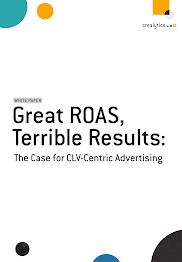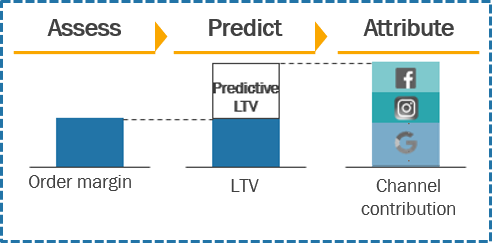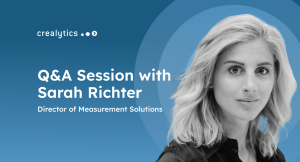Performance advertising as we know it is changing. In an era of advanced-AI platforms, staying competitive means activating data points that are unique to your business and customer base. Learn how smarter data ingestion and data maturity can help online retailers stand out from the crowd.
Plenty of industries have experienced their watershed moment. From Henry Ford’s assembly lines to streaming services, executives face the same question when the old way of doing things goes stale:
“How can I futureproof my company?”
Online retail is waking up to a similar dilemma. Advanced AI has diluted any technological advantage for in-house and agency players alike.
Many firms competed on their best-in-class bidding platforms. Now, thanks to a new generation of media management systems, they find themselves on a level playing field.
Campaign tactics and operational adjustments have become less relevant to your success as an online retailer. From hereon in, feeding biddable media platforms with smarter data provides your best chance to remain competitive.
Advanced automation and data activation
Just how did the performance marketing industry find itself in a commoditized bidding environment?
Let’s take a bird’s eye view of the industry’s evolution so far. Certain best practices have evolved more readily than others; and the main players – Google and Facebook – have accelerated these changes by introducing advanced AI.
Whereas manual or rule-based frameworks once dominated our industry, advanced automation has taken over.
Take Google Smart Bidding. In the last 18 months its machine-learning algorithms have improved exponentially. Every user can rely on maximum efficiency.
How does Google Smart Bidding work?
Smart Bidding represents a subset of automated bid strategies; and each strategy optimizes for either conversions or conversion value.
Google uses machine learning to achieve the most optimal bids possible, in turn maximizing conversion value across your campaign or bidding portfolio.
The search giant offers several Smart Bidding strategies, including Target CPA, Maximize conversion and Maximize conversion value.
However, for the purpose of this article, we’ll focus on Target ROAS – the algorithm dedicated to achieving the best Return on Ad Spend possible.
But be warned, although Target ROAS blows other ROAS-driven bidding tools out of the water, it doesn’t guarantee the long-term results you might hope for. Maximum efficiency doesn’t equate to maximum effectiveness.
To use an old analogy, automation might help you go faster than ever before, but not necessarily in the right direction. This leads to a major, related point.
A costly transition from ROAS
Unlike bidding technology, our industry’s primary KPI remains stubbornly familiar. Return on Ad Spend (ROAS) persists as the go-to metric for many advertisers despite its vast limitations. Why hasn’t this fallen out of favor in the same way old technology has?
For one thing, it provides an easy yard stick for those who set budgets. ROAS does a great job in delivering top-line revenue. And what’s more, achieving ostensibly decent numbers proves fiendishly straight forward thanks to tried-and-tested methods.
Set marketers ambitious ROAS goals and they’ll likely use retargeting or brand campaigns to achieve them.
Ironically, it’s the results of these methods that have caused advertisers to question their favorite metric.
Retargeting campaigns reflect ROAS’s chief weakness: they ignore incremental value. As a result, some of the world’s biggest retailers have reached a costly conclusion: their vast ad budgets only served to attract shoppers who would have purchased anyway. They wasted millions in exchange for inflated numbers.
The reaction has been twofold. Organizations are no longer settling for top-line revenues: they’re starting to seek granular measurements of their customer and purchase data instead. This in turn has helped them pivot to a metric more aligned with corporate profitability: Customer Lifetime Value (CLV).


In many ways, CLV does all the things does all the things ROAS doesn’t. It promotes long-term growth, emphasizes bottom-line revenue and the acquisition of high-quality, new customers. Pioneering advertisers now factor in the exact margin of their products – along with new customer value – to get a better measure of their campaigns.
Using data to differentiate
As it stands, thousands of retailers find themselves caught between the old and new way of doing things. Most now use the latest, AI-driven bidding. But by default, these platforms are optimized toward ineffective metrics. Think about it. Smart Bidding’s Target ROAS algorithms chase down revenue targets.
If you happen to be in this group, you have the perfect opportunity to differentiate. How? By switching up the data these platforms ingest – and “feeding” them product margins and customer values. Data maturity can make or break your biddable media strategy.
We’ve found huge success implementing this approach for retailers at Crealytics.
The principle orbits around yielding new, loyal customers – the group most likely to make repeat purchases and drive your bottom line.
How can I understand the true value of an eCommerce purchase?
First of all, it starts with tracking the journey to understand the true value of a purchase.
With so many different ads to click on, it’s important to map buying decisions from initial customer engagement right through to conversion.


Assigning the right level of value to each paid media touchpoint
Next up, with tracking accounted for, we can assign an appropriate, proportional value to each paid media touchpoint.
This stage is integral. We need to determine a precise and accurate customer value – which means calculating exact margin. New customers hold particular sway here.
Then, after measuring the exact value of each purchase (including COGs) and feeding back any returns or cancellations to refine our optimization, we’re left with the contributed order margin for an individual buyer.
Discovering individual order margins


Adding a predictive lifetime value to an order margin
Remember the focus on new customers? Adding a predicted lifetime value to the original order margin (to reflect their expected future purchases) generates a 12-month lifetime value. Integrating with an attribution system ensures this value is assigned proportionally across all channels.


With this accounted for, we can feed each conversion back into the system in order to activate the data appropriately.
Smart Bidding offers a good example of how this ingestion works in practice. Instead of feeding it a diet of revenue figures, you feed it the lifetime profits you’ve calculated.
Its algorithms then adapt to a new, more valuable target and behave accordingly – de-investing from low-value areas and reallocating budget to areas with more value.
A smarter, more targeted future
Just because some retailers have woken up to the power of data maturity, it doesn’t mean everyone has. Many organizations remain addicted to short-term profits – along with the targeting of any old customer, regardless of their potential value.
But decision makers can’t ignore shrinking margins. In an ever-more competitive industry, a wider shift toward long-term business health seems inevitable.
Smarter data ingestion and a stronger grip on data maturity forms a cornerstone of this new approach. The sooner you apply it to your campaigns, the better your investments across all media channels.
Want a better understanding of how Performance Advertising KPIs have evolved? This five-minute read might be for you.




